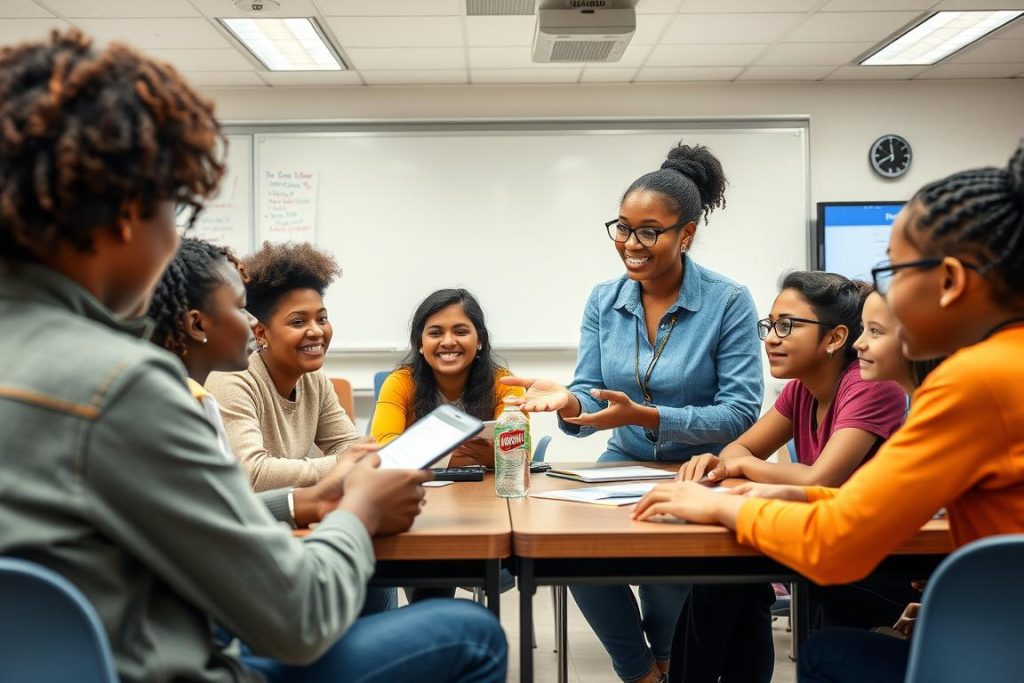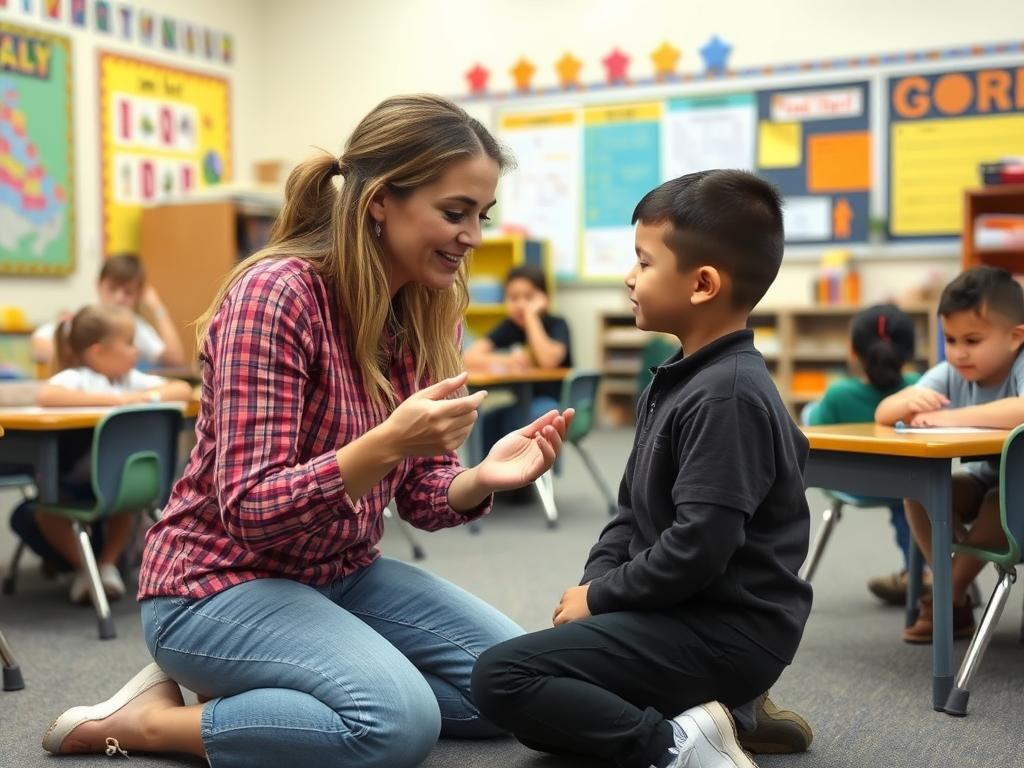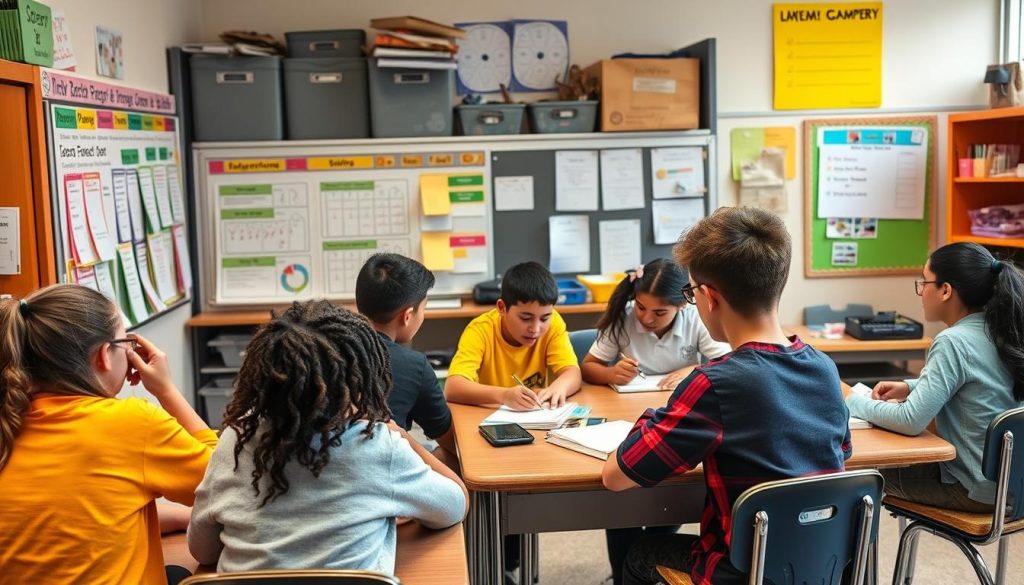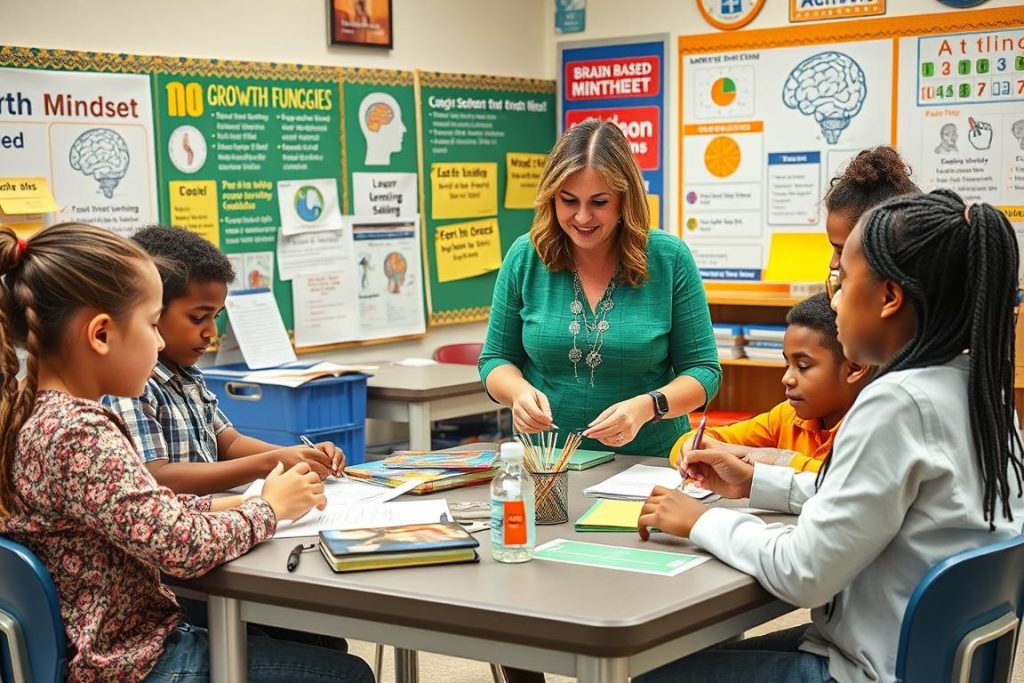The Empowered Brain: Understanding How Students Learn
Understanding brain function helps teachers develop targeted strategies to empower student learning.
Before diving into practical applications, it’s essential to understand some fundamental brain processes that impact learning. The brain’s remarkable plasticity—its ability to form new neural connections throughout life—means that learning environments can physically shape brain development. This knowledge alone can revolutionize your teacher skills and approach to instruction.
Research shows that when students feel empowered in their learning journey, their brains actually function more efficiently. The prefrontal cortex, responsible for executive functions like planning and decision-making, becomes more active when students have agency in their learning process. This scientific reality underscores why creating empowered classroom environments isn’t just philosophically sound—it’s biologically beneficial.
Neuroscientists have identified several key brain mechanisms that directly impact learning, including:
- Attention networks that determine what information gets processed
- Memory systems that encode, store, and retrieve information
- Emotional circuits that influence motivation and engagement
- Executive function networks that manage planning and self-regulation
Understanding these systems allows teachers to design instruction that works with—rather than against—the brain’s natural learning processes. This knowledge forms the foundation for developing advanced teacher skills that can transform classroom dynamics.
Deepen Your Understanding of Brain-Based Learning
Discover research-backed strategies to enhance your teacher skills through our comprehensive course on brain research applications in the classroom.
How Stress Affects the Empowered Learning Environment

Creating low-stress learning environments helps students’ brains function optimally.
Neuroscience research has revealed the profound impact stress has on the learning brain. When students experience chronic stress or anxiety, the amygdala (the brain’s emotional center) becomes overactive, while the prefrontal cortex—essential for higher-order thinking—becomes less efficient. This biological reality has significant implications for how we develop our teacher skills and structure our classrooms.
According to a 2014 study published in the Journal of Neuroscience, even mild stress can impair the brain’s ability to form new memories and retrieve existing ones. For teachers seeking to create empowered learning environments, addressing stress becomes not just a matter of emotional comfort but of cognitive function.
Effective teacher skills for reducing classroom stress include:
Physiological Approaches
- Incorporating movement breaks to reduce cortisol levels
- Teaching simple breathing techniques for stress management
- Creating sensory-friendly spaces for overstimulated students
Psychological Approaches
- Establishing predictable routines that reduce uncertainty
- Using growth mindset language that normalizes challenges
- Providing appropriate levels of choice and control
When students feel safe and supported, their brains are biologically primed for learning. The hippocampus—crucial for forming new memories—functions optimally in low-stress environments. By developing teacher skills that create these conditions, you’re not just making students feel better; you’re literally enhancing their brain’s capacity to learn.
“The most effective teachers understand that learning is as much emotional as it is cognitive. When we address the emotional needs of our students through brain-aware practices, we unlock their full learning potential.”
Dr. Mary Helen Immordino-Yang, Educational Neuroscientist
Capturing Attention in the Empowered Classroom

Varying instructional approaches helps maintain attention and creates empowered learners.
Neuroscience has transformed our understanding of attention—a prerequisite for learning. The brain’s attention networks are not designed for the sustained focus often demanded in traditional classrooms. Instead, our brains are wired to notice novelty, respond to emotion, and seek meaning. Developing teacher skills that work with these natural tendencies can dramatically improve student engagement.
Research from the field of cognitive neuroscience shows that the brain processes information in approximately 10-minute cycles before requiring a reset. This finding has profound implications for how we structure lessons and develop our teacher skills. Breaking instruction into shorter segments with varied activities aligns with the brain’s natural attention patterns.
Neuroscience-Based Attention Strategies
Novelty
The brain’s reticular activating system is naturally drawn to what’s new or unexpected. Introducing surprising elements, changing voice patterns, or using unusual examples can reset attention.
Relevance
The brain prioritizes information it deems personally meaningful. Connecting content to students’ lives activates motivation centers in the brain, enhancing attention and retention.
Multi-Sensory Input
Information presented through multiple sensory channels creates stronger neural networks. Combining visual, auditory, and kinesthetic elements strengthens learning pathways.
Developing these teacher skills doesn’t require a complete overhaul of your teaching style. Small, strategic adjustments based on neuroscience principles can yield significant improvements in student attention and engagement. The key is understanding that attention isn’t just about willpower—it’s about working with the brain’s natural tendencies.
When students are genuinely engaged, they’re more likely to feel empowered in their learning. This sense of empowerment creates a positive feedback loop: engagement leads to success, which increases motivation, which further enhances engagement.
Quick Tip: The “primacy-recency effect” in memory formation means students best remember what happens at the beginning and end of a learning session. Place your most important content in these prime spots, and use the middle for practice and application.
Memory Formation in the Empowered Student
Memory isn’t a single process but involves multiple brain systems working together. Neuroscience research has identified distinct memory pathways that have direct implications for classroom instruction and teacher skills development. Understanding these systems allows teachers to design learning experiences that maximize retention and transfer.
The journey from short-term to long-term memory involves several critical processes:
- Encoding: Information enters working memory, which has limited capacity
- Consolidation: New learning is connected to existing knowledge
- Storage: Information is organized and filed in long-term memory
- Retrieval: Stored information is accessed when needed
Each of these stages can be enhanced through specific teacher skills and instructional strategies. For example, research shows that spaced practice—revisiting material at increasing intervals—significantly improves long-term retention compared to massed practice (cramming). This finding has revolutionized how effective teachers approach review and assessment.
| Memory Challenge | Brain-Based Solution | Classroom Application |
| Limited working memory capacity | Chunking information into meaningful units | Organize content into 3-5 key concepts per lesson |
| Weak initial encoding | Elaborative rehearsal (processing meaning) | Have students explain concepts in their own words |
| Rapid forgetting | Spaced retrieval practice | Brief review activities at strategic intervals |
| Difficulty with transfer | Creating multiple neural pathways | Apply concepts in varied contexts and formats |
When students understand how their memory works, they become more empowered learners. Teaching students about these brain processes—a strategy called metacognition—gives them greater agency in their learning journey. This approach transforms teacher skills from simply delivering content to facilitating students’ understanding of their own learning processes.
Effective teachers recognize that emotional engagement also plays a crucial role in memory formation. The amygdala, which processes emotional responses, helps tag experiences as important for the hippocampus to encode into long-term memory. This is why emotionally resonant learning experiences are often remembered long after neutral content is forgotten.
Enhance Your Memory-Boosting Teacher Skills
Access research-based strategies and ready-to-use activities that help students build stronger memory connections.
Emotional Regulation and the Empowered Learner

Teaching emotional regulation skills creates more empowered, resilient learners.
Neuroscience research has revealed the intricate connection between emotion and cognition. The brain’s emotional and thinking centers are not separate systems but deeply interconnected networks that constantly influence each other. This understanding has profound implications for developing teacher skills that address the whole child.
According to research highlighted by Edutopia, emotional regulation directly impacts cognitive function. When students can effectively manage their emotions, they show improved:
- Working memory capacity
- Cognitive flexibility
- Sustained attention
- Decision-making abilities
Developing teacher skills in this area involves both explicit instruction in emotional regulation strategies and creating classroom environments that support emotional well-being. When students feel emotionally safe and equipped with self-regulation tools, they become more empowered learners.
“Emotion is the gateway to attention, which is the gateway to learning. We cannot separate the emotional brain from the learning brain.”
Dr. Judy Willis, Neurologist and Teacher
Practical strategies for developing emotional regulation in your classroom include:
For Individual Students
- Teaching mindfulness practices that strengthen the prefrontal cortex
- Providing emotional vocabulary to help name and tame feelings
- Creating personalized calming strategies based on sensory preferences
For the Classroom Community
- Establishing predictable routines that reduce anxiety
- Modeling healthy emotional expression and regulation
- Creating designated spaces for emotional reset when needed
These approaches aren’t just “nice to have”—they’re essential teacher skills based on how the brain functions. Neuroscience shows that emotional regulation isn’t separate from academic learning but foundational to it. When we help students manage their emotions, we’re literally helping their brains function more effectively.
The development of these teacher skills represents a shift from viewing emotions as distractions from learning to recognizing them as integral to the learning process. This perspective empowers both teachers and students to work with, rather than against, the brain’s natural functioning.
Building Executive Function in Empowered Students

Structured activities that develop executive function create more independent, empowered learners.
Executive function skills—including working memory, cognitive flexibility, and inhibitory control—are critical for academic success and lifelong learning. Neuroscience research has shown that these skills, centered in the prefrontal cortex, continue developing into early adulthood. This extended development window gives teachers a significant opportunity to influence these crucial capabilities.
Developing teacher skills that support executive function means understanding that these abilities aren’t fixed traits but learnable skills that respond to targeted instruction and practice. When teachers explicitly teach and scaffold executive function skills, they empower students to become more independent, self-directed learners.
Core Executive Function Skills
Working Memory
The ability to hold and manipulate information in mind. This skill allows students to follow multi-step instructions, take notes while listening, and connect new information to prior knowledge.
Cognitive Flexibility
The capacity to switch perspectives, adapt to changing demands, and consider alternative approaches. This skill helps students revise work, apply feedback, and solve problems creatively.
Inhibitory Control
The ability to resist impulses, maintain focus despite distractions, and think before acting. This skill supports sustained attention, thoughtful participation, and social regulation.
Research from developmental neuroscience shows that these skills develop through a combination of maturation and experience. Teachers can accelerate this development by providing structured opportunities for practice within the curriculum. These aren’t separate activities but can be integrated into existing content instruction.
Effective teacher skills for supporting executive function development include:
- Teaching explicit strategies for organization and planning
- Providing visual supports that reduce cognitive load
- Gradually releasing responsibility as students develop independence
- Offering specific feedback on process and strategy use
- Creating classroom routines that build self-regulation
When students develop strong executive function skills, they become more empowered learners who can manage their own learning processes. This shift from external to internal regulation is a key marker of student growth and development.
Research Insight: Studies show that executive function skills are stronger predictors of academic success than IQ. Developing these skills can help close achievement gaps and support all learners.
Develop Your Executive Function Teaching Skills
Access practical strategies and classroom-ready tools to help your students build essential executive function skills.
Practical Strategies for Creating an Empowered Classroom

Implementing brain-based strategies creates more engaged, empowered learners.
Translating neuroscience research into everyday classroom practice requires developing specific teacher skills that align with how the brain learns. Here are practical, evidence-based strategies you can implement immediately to create a more empowered learning environment:
How can I structure lessons to work with attention spans?
Break lessons into 10-15 minute segments, shifting between different modalities (listening, discussing, writing, moving). This aligns with the brain’s natural attention cycles and prevents cognitive fatigue. Use “brain breaks” that involve movement to reset attention networks and improve focus for the next learning segment.
What memory-enhancing techniques are most effective?
Implement retrieval practice by having students regularly recall information without looking at notes. Research shows this strengthens memory more effectively than re-reading or highlighting. Use spaced repetition by revisiting key concepts at increasing intervals (1 day, 3 days, 1 week). Create meaningful connections between new content and existing knowledge through analogies, visual mapping, or real-world applications.
How can I reduce stress while maintaining high expectations?
Provide clear success criteria so students understand expectations. Break complex tasks into manageable steps with checkpoints. Create a “mistake-friendly” classroom culture that normalizes error as part of learning. Teach specific stress-management techniques like deep breathing or positive self-talk that students can use independently.
What classroom design elements support brain-based learning?
Create flexible seating options that allow for different types of learning activities. Reduce visual clutter that can overload sensory processing. Incorporate natural elements like plants and natural light that have been shown to reduce stress and improve cognitive function. Design specific areas for collaboration, quiet work, and emotional regulation to support different brain states.
Developing these teacher skills doesn’t happen overnight. Start by selecting one or two strategies that align with your current teaching context and student needs. As you become comfortable with these approaches, gradually incorporate additional brain-based practices into your repertoire.
Remember that creating an empowered classroom is as much about your mindset as your methods. When you approach teaching with curiosity about how the brain learns, you model the growth mindset you hope to instill in your students.
Transform Your Teaching with Brain-Based Strategies
Join our community of educators committed to applying neuroscience research in their classrooms. Access resources, connect with like-minded teachers, and enhance your teacher skills.
Becoming an Empowered Teacher of Empowered Students

When teachers feel empowered with neuroscience knowledge, they create more empowered students.
The journey to creating an empowered classroom begins with your own professional growth. By developing teacher skills grounded in neuroscience, you transform not just how you teach, but how your students experience learning. This transformation isn’t about adopting trendy techniques but about aligning your practice with how the brain naturally learns.
As you implement these brain-based strategies, you’ll likely notice changes in your classroom:
- Students taking more ownership of their learning journey
- Increased engagement and motivation across diverse learners
- More efficient learning with better long-term retention
- Improved emotional regulation and classroom climate
- Stronger executive function skills that transfer across subjects
These outcomes aren’t just beneficial for academic achievement—they’re essential life skills that empower students beyond the classroom. By developing teacher skills that support the whole brain, you’re preparing students for success in a complex, rapidly changing world.
Remember that implementing neuroscience in the classroom is itself a learning journey. Start small, observe carefully, and adjust your approach based on your students’ responses. The most effective teachers are those who remain curious about how learning happens and flexible in their approach.
As you continue to develop your teacher skills in this area, connect with other educators who share your interest in brain-based learning. Professional learning communities provide valuable support, fresh ideas, and opportunities to reflect on your practice.
Continue Your Neuroscience Learning Journey
Deepen your understanding of how to create empowered learning environments through our comprehensive professional development resources.



